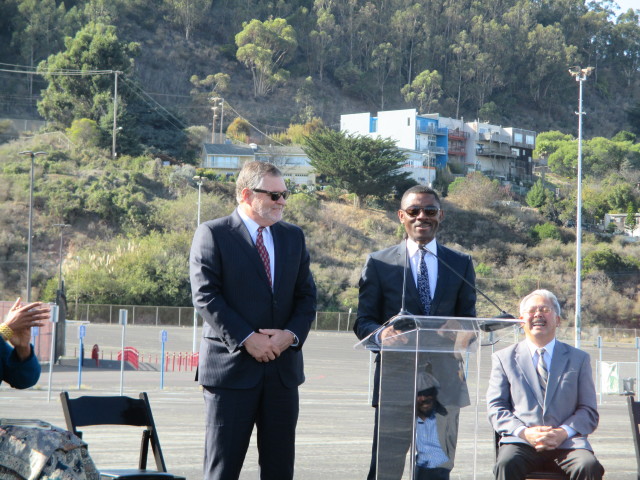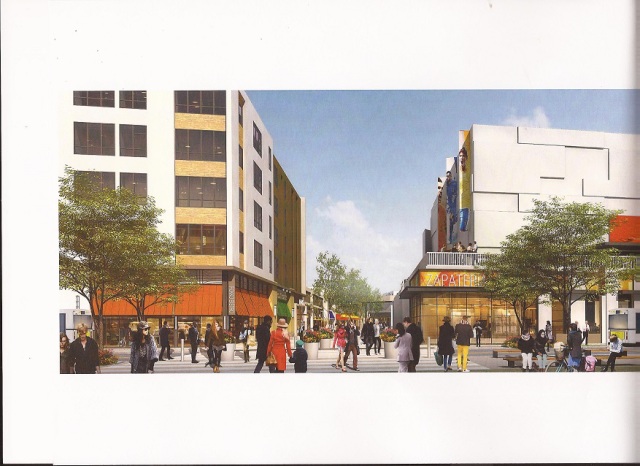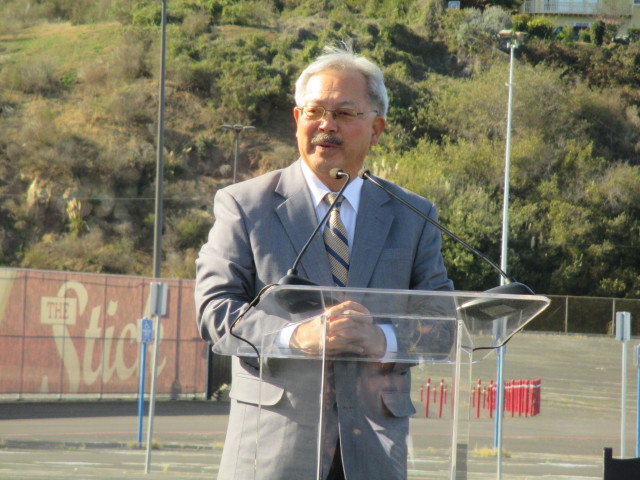
By Tim Redmond
NOVEMBER 18, 2014 — The next stage of the redevelopment of Hunters Point Bayview was on display today in a sunny, almost wind-free Candlestick parking lot – and Kofi Bonner, the head of developer Lennar Urban, put it this way:
“I see shopping in everyone’s future.”
Bonner and Randy Brant, executive vice president of the mall developer Macerich, were there to announce that the old stadium would be replaced with a high-end shopping mall featuring the likes of Gucci and Armani.
The mall, with 130 stores, would be the centerpiece of Lennar’s ambitious plans to build 6,000 housing units at Candlestick Point, with 32 percent of them available at below-market rate.
Rev. Aurelious Walker, pastor of the True Hope Church of God, said the image of the neighborhood as a “poor, crime-ridden community” would be “totally obliterated” by the development.
Or, as Bonner put it, “we will create an environment very similar to what other San Franciscans enjoy.”

That’s a lot to put on a shopping mall, particularly one that is expected to draw its customers from the entire city and region, not just (or even primarily) from Bayview Hunters Point. A new supermarket (badly needed in the area) will serve the community, but Bonner told me that “most malls don’t rely on the area within one mile” for a customer base.
There will be 2,400 underground parking spaces.
Of course, the mall is only a part of the project at Candlestick and the old shipyard that will eventually total 12,000 housing units. The first few have already been built and sold, Bonner said, and 60 percent of the buyers were San Francisco residents.
“It’s a diverse group, first-time homebuyers, local people, some tech people,” he said.
The new market-rate units sell for between $500,000 and $1 million, he said. BMR units will sell for about $250,000.
Lee and Bonner both repeated the mayor’s political mantra – jobs, jobs, jobs. The Candlestick project – which will also include an entertainment center and restaurant village — will create some 3,000 permanent jobs, they said.
There’s a lot of BMR housing in this mix, more than we’re seeing anywhere else in the city. It’s about half of what’s needed, and is just barely in line with the affordable housing measure, Prop. K, that the mayor supported and the voters approved.
Prop. K says that 33 percent of all new housing should be BMR.

I asked the mayor if he thought that retail jobs – not known for high wages – would pay enough to allow the workers to afford to live in San Francisco. “We just passed the highest minimum wage in the country,” he said. By the time the stores open, he noted, employers will be required to pay $15 an hour.
That is, indeed, higher than most places. The cost of housing here is also vastly higher than most places. And if my math is right, $15 an hour for a 40-hour week is a little more than $30,000 a year.
Under federal guidelines, a person making $30,000 a year should pay about $10,000 a year for housing, or $800 a month. Assume two people working those jobs share a unit, and you’ve got about $1,600 a month for rent.
The lowest market-rate unit, at $500,000, would require a monthly payment of $2,541, according to the online mortgage-rate calculator I checked, and that’s based on a rock-bottom interest rate of 3.5 percent. At a more likely 4 percent, it’s $2,669 a month.
And since many of these units are condos, there will also be homeowners association fees that amount to hundreds of dollars a month.
So a retail worker at the new mall will earn a little more than half what’s needed to buy the cheapest market-rate housing unit Lennar is planning to build. And that’s if the market-rate stays at the $500,000 level, which at this point is just a projection.
Lennar and Macerich have committed to a local-hire policy that will seek to employ half of the new workers from the city. That means 1,500 local jobs, many of them paying minimum wage, as is common in retail.
There will be about 1,800 BMR units in the complex.
Now: If my experience with shopping malls runs true to this new one, many of the workers will be young people who still live with their parents and are working to get through school. That’s a great thing and will be an immense help to those kids and their families. It will make it possible for some to pay for City College or SF State. That’s a huge deal. Youth unemployment is a major problem.
But it may not do as much for the adult unemployment problem, particularly since adults with families can’t possibly afford to live in this city on retail wages.
Of course, you can’t build this kind of a project without a large number of construction jobs, which pay pretty well – and if half of those are truly local hire (which has been very difficult to enforce in the past, since the construction unions operate by seniority) then the building process itself will benefit the community. As long as it lasts.
There was much talk at the press conference about how the new mall will cause housing values in the area to increase, which is great for homeowners who suffer from predatory loans and may be underwater right now. It is, however, always risky business, particularly in a city where displacement is rampant.
So I asked the mayor: If, as Kofi Bonner says, this is going to bring Bayview Hunters Point into line economically with the rest of the city – where housing prices and evictions are forcing thousands or working-class people to leave – what’s to prevent more displacement?
“We have some good strong programs,” he said. “Community stabilization programs. The local hire is very important – you have to have the income and the opportunities for displacement to be lessened.”
The city will get sales tax money. The developers expect to make out well, or they wouldn’t be doing this. There may be some locally owned businesses in the mall, but most of the tenants will be national chains – and the money you spend at Gucci leaves town that night.
It was all hype and excitement today. But I’m waiting to see how the numbers really add up.




